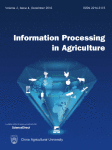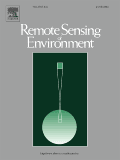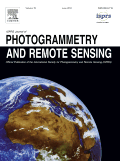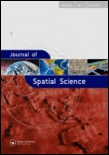
Science of Remote Sensing
Scope & Guideline
Unlocking the Potential of Remote Sensing Technologies
Introduction
Aims and Scopes
- Remote Sensing Technology Development:
The journal prioritizes advancements in remote sensing technologies, including the development of new satellite sensors, algorithms, and data processing techniques that enhance the accuracy and efficiency of remote sensing applications. - Environmental Monitoring and Assessment:
Research in this journal often addresses environmental monitoring, including changes in land cover, vegetation dynamics, and climate impacts, leveraging remote sensing data to provide insights into ecological and environmental health. - Agricultural Applications:
A significant area of focus is the application of remote sensing in agriculture, including crop yield estimation, land use mapping, and monitoring agricultural practices, which are vital for food security and sustainable farming. - Forest and Biomass Studies:
The journal includes extensive research on forest structure, biomass estimation, and forest dynamics, utilizing remote sensing to monitor and assess forest health and changes due to disturbances or climate factors. - Disaster Management and Risk Assessment:
The journal contributes to disaster management by utilizing remote sensing for monitoring natural disasters such as wildfires, floods, and landslides, providing critical data for risk assessment and response planning. - Integration of Remote Sensing and Machine Learning:
There is a growing emphasis on the integration of machine learning techniques with remote sensing data to enhance data analysis, classification, and predictive modeling capabilities.
Trending and Emerging
- High-Resolution Remote Sensing:
There is a growing trend towards utilizing high-resolution satellite imagery and data for detailed environmental assessments, enabling finer-scale monitoring of land cover and ecological changes. - Machine Learning and AI Integration:
The integration of machine learning and artificial intelligence in remote sensing data analysis is increasingly prevalent, enhancing the capabilities for data classification, anomaly detection, and predictive modeling. - Climate Change Impact Studies:
Research focusing on the impacts of climate change, particularly in relation to land cover changes, vegetation dynamics, and ecosystem responses, is gaining significant traction. - 3D and Lidar Applications:
The use of Lidar technology for three-dimensional modeling of landscapes, forests, and urban areas is emerging as a vital area of research, providing detailed insights into structural and spatial characteristics. - Resilience and Recovery Monitoring:
Studies examining the resilience of ecosystems and agricultural systems in response to disturbances, including conflict and climate impacts, are becoming more prominent, reflecting a broader interest in sustainability. - Satellite Data for Social Applications:
There is an increasing focus on the use of satellite data for social applications, such as monitoring agricultural practices in conflict zones or assessing the impacts of natural disasters on human communities.
Declining or Waning
- Traditional Land Cover Classification:
There seems to be a waning interest in traditional land cover classification methods that rely solely on optical imagery, as researchers increasingly adopt more sophisticated machine learning approaches and multi-sensor data integration. - Static Environmental Monitoring:
Research focusing on static environmental parameters, such as fixed vegetation indices, is becoming less prevalent as dynamic monitoring and time-series analysis gain more attention for understanding temporal changes. - Single-Sensor Studies:
The trend is moving away from studies that rely exclusively on a single type of remote sensing data. Instead, there is a shift towards multi-sensor approaches that combine data from various sources for comprehensive analysis. - Basic Remote Sensing Applications:
Simple applications of remote sensing without advanced analytical frameworks or integration with other data sources are becoming less common, as the field evolves towards more complex and interdisciplinary studies.
Similar Journals

Information Processing in Agriculture
Driving Innovation in Farming through Data and TechnologyInformation Processing in Agriculture, published by Elsevier, stands at the forefront of interdisciplinary research merging agriculture with cutting-edge computational techniques. With an impressive impact factor derived from its classification within the Q1 quartile across five critical categories—including Agronomy, Animal Science, Aquatic Science, Computer Science Applications, and Forestry—this journal exemplifies excellence in scholarly communication. Open Access since 2014, Information Processing in Agriculture not only democratizes access to pioneering research but also accelerates innovation by breaking barriers for researchers, professionals, and students alike. The journal's comprehensive scope facilitates crucial dialogue on the implications of processing technologies in farming practices, contributing significantly to advancements in sustainability and efficiency within the global agricultural sector. As it converges topics from 2014 to 2024, scholars are invited to explore and contribute to a robust platform dedicated to enhancing food security and environmental stewardship.

Frontiers in Remote Sensing
Leading the way in open-access remote sensing scholarship.Frontiers in Remote Sensing is an innovative open-access journal published by FRONTIERS MEDIA SA, dedicated to advancing the field of remote sensing through high-quality research and groundbreaking studies. Launched in 2020, this journal has quickly established itself as a pivotal platform for scientists and researchers working in the spheres of Physics and Astronomy and Biochemistry, Genetics, and Molecular Biology. With impressive rankings in Scopus, including a 68th percentile standing in Physics and Astronomy, it provides a vibrant forum for discussions on new methodologies, applications, and technological advancements in remote sensing. The journal is committed to facilitating knowledge dissemination by providing fully open access to its content, ensuring that useful scientific insights are readily available to a global audience. As it converges towards its initial evaluation period (2020 to 2024), Frontiers in Remote Sensing aims to solidify its role as a key resource for researchers, professionals, and students looking to innovate and excel in this dynamic field.

Nature Reviews Earth & Environment
Illuminating Insights on Planetary ChallengesNature Reviews Earth & Environment, published by SpringerNature, serves as an essential platform for researchers and professionals in the fields of environmental science, atmospheric science, and earth-surface processes. Since its inception in 2020, this distinguished journal has quickly established itself as a leading resource, achieving Q1 quartile rankings in multiple categories including Atmospheric Science and Pollution, reflecting its commitment to high-quality, impactful research. With an impressive Scopus ranking as #1 in its respective categories and a 99th percentile standing, the journal is pivotal for those seeking to explore cutting-edge advancements and critical insights in the interplay between our planet's environment and humanity. The publication encourages open discourse through its accessible content, aiming to inspire and inform its audience about pressing environmental challenges and innovative solutions. As it continues to converge through to 2024, Nature Reviews Earth & Environment stands out as a vital resource for anyone dedicated to understanding and preserving our planet.

Journal of Geovisualization and Spatial Analysis
Exploring the Intersection of Geography and InnovationJournal of Geovisualization and Spatial Analysis, published by SpringerNature, is an influential open-access journal specializing in the cutting-edge fields of geovisualization, spatial analysis, and their application in earth sciences and geography. Since its inception in 2017, this journal has established a prominent stance with a high impact factor and prestigious Q1 rankings across multiple categories, including Computers in Earth Sciences, Earth and Planetary Sciences (miscellaneous), and Geography, Planning and Development. The editorial board is committed to advancing innovative research and methodologies, providing a platform for scholars to disseminate their findings globally. With impressive Scopus rankings—placing it in the top percentiles among its peers—the journal serves as a vital resource for researchers, professionals, and students keen on understanding spatial data and its implications for geographic science. Its emphasis on rigorous peer review and rapid publication enhances accessibility to substantive research, thus fostering knowledge sharing within the scientific community. Based in Switzerland, the journal promotes a collaborative environment for interdisciplinary studies, making it an essential read for anyone involved in spatial analysis research.

REMOTE SENSING OF ENVIRONMENT
Exploring the Earth, One Pixel at a Time.REMOTE SENSING OF ENVIRONMENT, published by Elsevier Science Inc, is a premier academic journal specializing in the interdisciplinary field of earth observation and remote sensing technologies. With an impressive impact factor and classified in the Q1 category for Computer Science in Earth Sciences, Geology, and Soil Science as of 2023, this journal serves as a vital resource for researchers, professionals, and students alike. The journal, which has been disseminating high-quality research since its inception in 1969, provides a platform for the exploration of innovative methodologies and applications in the assessment of environmental changes and resource management through advanced imaging techniques. While not an open-access journal, REMOTE SENSING OF ENVIRONMENT offers access options that make cutting-edge research accessible to its audience. Its strategic focus on critical issues pertaining to environmental monitoring and sustainable practices underscores its role in enhancing our understanding of the planet’s dynamics.

Applied Geomatics
Bridging theory and practice in the world of geomatics.Applied Geomatics is an esteemed academic journal published by SPRINGER HEIDELBERG, dedicated to advancing the field of geomatics through rigorous research and innovative applications. With an ISSN of 1866-9298 and an E-ISSN of 1866-928X, this journal has gained a prominent standing in multiple disciplines, achieving a Q2 ranking in esteemed categories such as Earth and Planetary Sciences, Engineering, Environmental Science, and Geography. The journal's convergence of research from 2009 to 2024 positions it as a vital resource for both scholars and practitioners seeking to understand and leverage geomatic technologies in real-world scenarios. Located in Germany, Applied Geomatics not only contributes to theoretical advancements but also to practical methodologies that address current environmental challenges. Its accessibility and relevance ensure that the findings discussed within its pages are pivotal for professionals, researchers, and students alike, fostering collaboration and innovation within the field.

ISPRS JOURNAL OF PHOTOGRAMMETRY AND REMOTE SENSING
Empowering Researchers with Cutting-Edge InsightsISPRS Journal of Photogrammetry and Remote Sensing is a prestigious publication at the forefront of the fields of photogrammetry and remote sensing. Established in 1989 and published by Elsevier, this journal has consistently maintained a strong academic standing, currently holding a top-tier Q1 ranking across multiple categories, including Atomic and Molecular Physics, Computer Science Applications, and Engineering. This reflects its vital contribution to advancing knowledge and technology in these dynamic fields. The journal is not only a vital resource for researchers and professionals but also serves as an essential academic platform for students keen on delving into the latest developments in geospatial sciences. The journal operates under a non-open access model, ensuring that submitted research adheres to the highest standards of scholarly communication and integrity. With an impactful focus, it brings innovative research, comprehensive reviews, and significant case studies to a global audience. The ISPRS Journal is crucial for those aiming to enhance their understanding and application of remote sensing techniques within various scientific disciplines.

Remote Sensing
Exploring Earth's Mysteries Through Remote SensingRemote Sensing is a highly esteemed journal published by MDPI, dedicated to the domain of Earth and Planetary Sciences. With an impressive impact factor reflected in its rank of #16 out of 195 in the general Earth and Planetary Sciences category, this journal achieves a commendable 92nd percentile among its peers, indicating its significant contribution to the field. Since its inception in 2009 as an Open Access journal, it has enabled researchers, professionals, and students from around the globe to access high-quality, peer-reviewed articles that delve into the latest advancements in remote sensing technologies, methodologies, and applications. Based in Switzerland, Remote Sensing serves as a vital platform for disseminating innovative research that supports and enhances our understanding of Earth's processes and environments, ensuring scientific knowledge remains freely accessible and impactful.

INTERNATIONAL JOURNAL OF REMOTE SENSING
Shaping the Future of Earth and Planetary SciencesInternational Journal of Remote Sensing, published by Taylor & Francis Ltd, stands at the forefront of Earth and Planetary Sciences, providing a critical platform for disseminating pioneering research since its inception in 1980. With an impressive ranking of #25 out of 195 in general Earth and Planetary Sciences and a notable 87th percentile on Scopus, this journal is recognized for its high-quality contributions that span diverse topics including satellite imagery analysis, geospatial technologies, and environmental monitoring. As a Q1 journal in its field for 2023, it offers invaluable insights and methodologies that are essential for researchers, professionals, and students alike. Although not Open Access, the journal facilitates a comprehensive understanding of remote sensing sciences, ensuring that the scholarly community remains updated with the latest advancements, trends, and applications that impact global challenges.

Journal of Spatial Science
Illuminating Connections in Atmospheric and Energy ResearchThe Journal of Spatial Science, published by Taylor & Francis Ltd, serves as a prominent platform for the dissemination of research in the interdisciplinary fields of geography, atmospheric science, and energy. With an ISSN of 1449-8596 and an E-ISSN of 1836-5655, this journal has established itself as a vital resource since its inception in 2004, boasting an impressive convergence period extending to 2024. Recognized in the Q3 quartile for Atmospheric Science and Energy (miscellaneous), and achieving a Q2 classification in Geography, Planning and Development in 2023, the journal not only reflects the evolving complexities of spatial science but also underscores its increasing relevance in addressing contemporary global challenges. The journal holds a commendable position in Scopus rankings, with notable placements in various categories, further highlighting its academic significance. Researchers, professionals, and students are encouraged to engage with the rich content offered, as the Journal of Spatial Science remains committed to advancing knowledge and fostering discussions pertinent to spatial analysis and its applications.